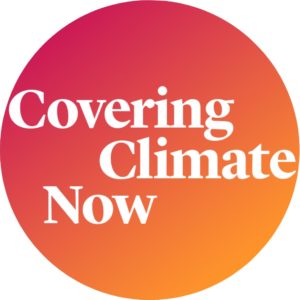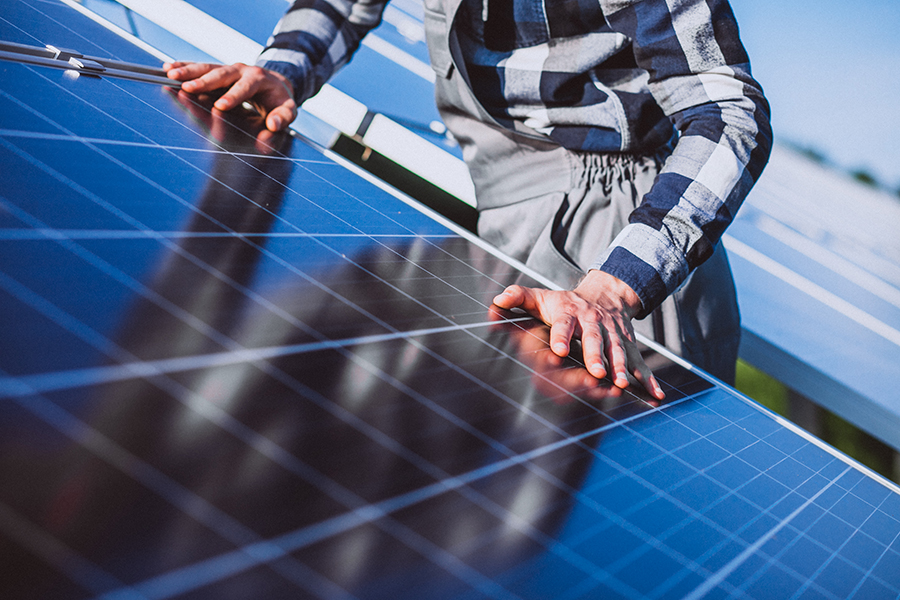Carlos Alberto Velázquez López is on a mission to make the island 100% powered by renewables before 2050.
When Category 4 Hurricane Maria hit Puerto Rico in September 2017, Carlos Alberto Velázquez López worked for a small solar installation company. What he saw in the aftermath — including some communities going without power for 11 months — was life-changing for the former U.S. Marine. No longer content with working on solar system installations for individuals, Velázquez López shifted his focus to helping entire communities.
Today, Velázquez López is the program director for Interstate Renewable Energy Council, or IREC, in Puerto Rico, which aims to rapidly expand access to renewable energy. He oversees the group’s solar business accelerator, helping remote and rural communities on the island achieve energy resiliency through the creation of community-centered microgrids made up of solar panels and battery storage.
Yale Climate Connections talked with Velázquez López about why this issue is important to him and about the microgrid projects IREC is spearheading in the remote mountain communities of Castañer and Maricao.
Yale Climate Connections: What makes you passionate about this work?
Carlos Alberto Velázquez López: I live in a very comfortable neighborhood in Puerto Rico. And Sept. 20, 2017, I wake up, and I look around, and everything is destroyed. And I have no power. I have no water. And I’m going, “OK, I can make do.” We got some panels up here. We had no batteries yet because at that time nobody had batteries. But 100% of Puerto Rico’s population did not have energy, 100%. And the best estimates that we got, when communication was restored a couple of days later to certain sectors, was that at best, at best, we can hope for the power to be restored within two months. To me, that was unacceptable.
And what it actually turned out to be was some communities did not get power restored until 11 months later. Now when you add to that the fact that 3,500 people in Puerto Rico died, not because of the immediate floods, or wind, or fires, but because they couldn’t get timely access to their hospital care, because of lack of electricity for dialysis, for their medicine, for their health maintenance, to me that was very unacceptable. And, from my perspective, not that it means any more because all citizens are the same, but I am a U.S. Marine veteran, and I thought to myself, “Just because we live in Puerto Rico, this is the sort of electrical service that we can aspire to.” That was really unacceptable to me.
I was a general manager for a small solar installation company, and I said to myself, “We cannot continue to do individual installs. We have to shift our focus and our mentality to community-based installs so that we can impact positively a lot more people in one effort.” And that’s when I immediately shifted from the private business enterprise to making coalitions with nonprofit organizations and to making coalitions with academia and to try to leverage government funds and opportunities and programs so that we could impact more than one household at a time. And if we could, to make sure that we benefited those more vulnerable and higher-needs first, because by pure market forces, not everybody was going to be able to afford, or have, energy resiliency in their home. And to me that was unfair. So that’s what makes me passionate.
YCC: What is the Puerto Rican solar business accelerator that IREC runs, and why was it needed?
Velázquez López: Puerto Rico, after Hurricane Maria, experienced an outage that impacted almost 100% of the population. And certainly, it was important to begin that transition or to ramp up and speed up the transition towards energy resiliency that leaned on renewable energy and storage for the sake of resiliency.
Forty-three percent of Puerto Rico’s population is below the federal poverty guidelines. And the energy burden for your typical Puerto Rican family could be upwards of nine to 11%, which is much higher than the average for the United States continental, which is about 3%. So Puerto Rico is really a place that needs the attention of the opportunity for us to improve our energy system.
We’re pleased with the present efforts of the Department of Energy and what we’re doing with the PR100, identifying different pathways to get Puerto Rico to 100% renewable [electricity] by 2050. We think it could be done much, much sooner than 2050. It has to be done much sooner than 2050. I don’t think the climate — I don’t think the Earth — can afford to wait that long.
So the solar accelerator, the way we envision it, is to really establish the foundation for the transition, which includes a competent workforce and which includes community-led or community-centered microgrid projects in remote and rural areas of Puerto Rico. And it also includes a robust and diverse solar financing structure that allows folks in the lower- and moderate-income of folks to make that transition as well.
YCC: What does it mean to make microgrids community-centered?
Velázquez López: Every community is different, and every community has different needs and different priorities that they can verbalize to you. When you go to a particular community, they’re the ones who have experienced the outage. They’re the ones who experienced the hardship after Hurricane Maria, and they’re the ones who can help us establish the priority for how electricity should be used in that particular community.
So for example, a community center where people in the neighborhood can actually go to obtain basic necessities like charge their telephone, or charge their computer, or if they need some kind of respiratory therapy, or if they need to do some kind of community meeting to make sure that everybody’s OK, that sort of thing. And then, of course, community-centered really means engaging that particular neighborhood, or that particular community, in an extended dialogue that tells us — the folks who are doing the financing or designing — what are the priorities for the use of energy in that particular place?
And it differs for every community. So a community may say there are people who are bedridden in our community that need power first, or we need to prioritize them. Or they may say there are essential businesses — like a small supermarket, or a bakery, or a gas station — that without that being operational, the quality of life for everybody else really suffers. So community-centered power is nothing but an extended dialogue and for us to listen, so when we design a resiliency project we take their priorities into consideration.
YCC: Can you talk a little bit about the two communities where you’re working on the microgrid projects and a little bit about that community-centered process?
Velázquez López: In the community of Castañer, one of the first [microgrids] that we did, one of the things that was really useful about that community is that it has about a 40-year experience of organizing. They’ve come together to make the best optimal use of their school, they created housing for migrant farmworkers, they’ve actually commissioned a community-led hospital that provides quite advanced care for thousands of residents within that remote area. So it was great working with them because they are very structured and they’re very organized and it was easy to really dialogue with them.
So immediately they told us that the hospital is a critical component. But then other businesses were also identified, like the community bakery, like the Postal Service. So they came together to identify for us what those essential businesses were that create a better quality of life for the residents in general.
In terms of Maricao, it was a different sort of conversation. The conversation in Maricao was really led by the municipal government and the mayor. So the mayor and his political structure really participated in identifying the local bank, the local hardware store, local migrant health clinic, so it was really sort of a municipal-led participatory approach.
The project in Castañer was inaugurated in June of 2022, and then the one in Maricao is in the design phase now, and hopefully it’ll be getting constructed within the next couple of months.
YCC: How have the residents and business owners in Castañer reacted?
Velázquez López: They’re very pleased and they’re very happy to have participated in this process. A few months after the project was in inaugurated and working, Hurricane Fiona hit Puerto Rico, everybody loses power. Not only did the folks in Castañer never lose power [at the buildings connected to the microgrid], but also other residents of that local region were able to come into the business sector and draw electricity for basic necessities like respiratory therapy and that sort of thing. So they were extremely excited and extremely happy to have done that project.
But they also said that we should look at, or the electric co-op that developed this with them should look at increasing the size of the storage and increasing the size of the resiliency. [Microgrids work because] the excess energy that’s generated during the day can be stored and used during the nighttime or when the sun isn’t shining. So if after the storm the weather continues to be not sunny for a few days, they want to make sure that they have resiliency that last longer than you know, 24 and 48 hours, they want to go a little bit longer. So it’s an interesting approach. And they’re saying, “Hey, could we expand this?”
YCC: Is this a model that could then be scaled up and used in other locations?
Velázquez López: The answer to your question is really location and case-specific. But for Puerto Rico, we have an island that has about 1.3 or 1.4 million customers to the electrical grid. To provide electricity to those 1.4 million house households, there are 32,000 miles of distribution lines, 2,500 miles of transmission lines. So just on the transmission and the distribution system, it is a maintenance nightmare to keep that going in the face of Puerto Rico being in the center of a hurricane corridor, right?
So just from that alone, and the topography of Puerto Rico, which is quite hilly because of a mountainous range in the middle of Puerto Rico. And then you have vulnerable coast all within a very short distance. Absolutely 100% of our fossil fuel generation fleet is located within the coastal flood plains of any FEMA maps of the projections over the next 50 years. So it is critical to decentralize, it is critical to distribute that generation and that storage and create local distribution lines for sectors because that’s really, truly the only economic way to have everybody have resilient power, and it also provides environmental energy justice to communities.
Bridgett Ennis is co-founder of ChavoBart Digital Media, an audio and video production firm with a focus on scientific and environmental media. This story originally appeared at Yale Climate Connections and is republished here as part of Covering Climate Now, a global journalism collaboration strengthening coverage of the climate story.





